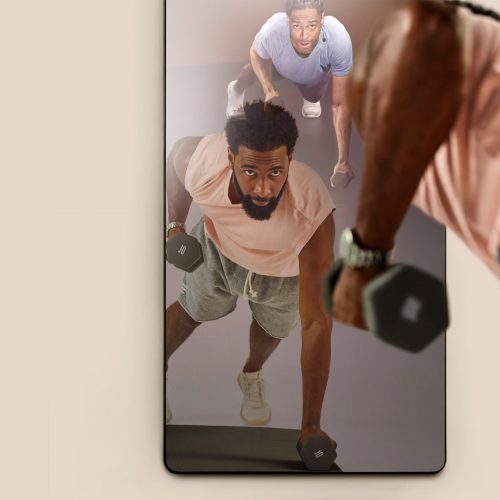May 5, 2021
 Today’s guest is: Trent Ward
Today’s guest is: Trent Ward
Who are they: Trent Ward is the founder and CEO of FORME Life.
Trent Ward is the co-founder and CEO of FORME Life. He realized first-hand that a busy lifestyle makes it challenging to get to the gym, and so in the middle of a successful finance career, he shifted focus to develop the most complete at-home fitness studio he could conceive. After more than four years, and teaming with virtuosos in every aspect of product and brand development. including renowned designer Yves Béhar, and legendary personal trainer, Harley Pasternak, the Studio was released.
Each day, FORME Life can deliver a personalized workout based on
the user’s preferences and current fitness journey. Aided by
machine learning and AI, the Full Studio can suggest the correct
resistance level for a given strength exercise and dynamically
adjusts as the user’s performance changes. FORME Life leverages its
stereoscopic cameras and advanced technology in human-centric
computer vision to provide accurate guidance on form and
technique.
When turned on, the display features a huge variety of live and
on-demand personal training sessions to suit individual needs with
a user-friendly touchscreen experience complete with voice
control. When turned off, FORME Life is a sleek mirror that
blends effortlessly into the rest of the home.
In this interview, we discuss: how the idea came about, the journey to creation, how to source the team you need, artificial intelligence, tips on how to make your own product and so much more.
Here are some key points that I would advise you to concentrate on
- Trent is CEO of FormeLife.
- Fitness can be convenient and accessible for all. Life can throw up a number of barriers to stop you from participating in sport, such as late-night working, travel delays, etc.
- Coronavirus has exposed our reliance on attending another physical location to work out and when travel restrictions are in place, we are forced to reevaluate how to work out in our own home and the benefits to our lifestyle that can bring.
- Why did they decide to look at a functional and aesthetic mode of accessory over a standard style of fitness equipment?
- How is his partnership with industrial designer Yves Béharwork, and who is responsible for which side of the project?
- Yves thinks about the human using the project over just considering the functionality of the project.
- How did they overcome the fear of starting a business?
- Trent went to a person who is knowledgeable about the industry and asked for feedback. Leave your ego at the door, be open to the knowledge of others and incorporate their teachings into the project direction or potential stoppage.
- Thinking about starting your own business? The success of Trent's project is the way it eliminates a human problem of shortness of time and accessibility of equipment. What problems in our lives could your project eliminate? How could you make our lives better?
- You do not need to do everything yourself. You can team up with people in the industry to help you make the product, improve its look, etc, etc. You can bring the idea and the money, and find suitable teams and companies to support your work.
- Did they use focus groups or other market research methods?
- What choices did they make with regards to the style and pricing of the equipment?
- Trent sells on value rather than price. A one-off initial payment might be worth more value to you than a subscription to the gym or an inferior product when you consider the time spent traveling, replacing broken equipment as it's badly made, spending on something you don't use as it cant fit into your life.
- How did they plan out the various training modules and equipment offered on their product? How did they plan the functionality for release and potential changes as the fitness industry changes over time?
- The planning they put into the artificial intelligence that was built for the product.
- Trent's team asked for feedback from people on their fitness and any potential roadblocks to them using their product. Instead of taking criticisms or no's to the heart, be open to their viewpoint - ask your customers, what would they require to purchase? What could be better, what would they be open to. Be open to change and project readjustment, as feedback may take you to a greater level of success than you ever thought possible.
- Different user types will need a different style of use, a different feedback method or intensity level, etc. With some planning and open feedback requests, you can merge different styles and appeal to a large customer base.
- Will there be an option to connect to a larger community from your unit?
- How did he source the people he required for the teams to manufacture the units, create the AI, work the offices etc.
- What does he want the evolution of 'The Studio' to be?
- Problems they encountered during the design, build, and marketing ... and the fixes they found to help.
- What is his definition of success with this product?
- What has he learned from this project to create the ultimate fitness product?
- "It's surprising how much of success is just showing up and keep pushing"
- Why did they decide to go with 'Forme' rather than 'Form' - are they worried about potential issues relating to the name?
- How can you find more information, connect with Trent and Forme Life?

